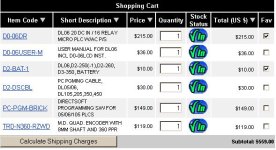Hi Folks,
I’ve been hanging around here for several months now, learning from the discussions, but not really feeling qualified to make a comment. I’ve been designing industrial machinery at various companies for well over twenty years -- everything from a fixture for gluing chicken feathers to wooden darts, to a machine for testing burial caskets by shaking them violently up and down. A little over a year ago I decided to go into business for myself, hiring my design and CAD services out to various industrial clients. It was slow getting started, but the past six months have been fairly busy. The reason for this post is that I think I’ve gotten myself in over my head with my latest project.
My educational background (and most of my work experience) is in mechanical engineering, though I have designed quite a few machines equipped with both relay and PLC control systems. In these instances, if more than a couple of relays was required, I would farm out the control design to an expert. For my part, I would develop a detailed list of inputs and outputs, as well as a detailed operational sequence for the person designing the control system. Sometimes they would build the panel, sometimes I would build it to their specs. So, I’ve been around this stuff for quite a while, though I’ve yet to design a complex control system from scratch. I’ve made minor modifications to others’ programs, but that doesn’t take a lot of smarts.
Anyway, I recently got the job of designing a fairly simple machine to automatically feed 1/8” dia. spring wire from a coil and cut it to specific lengths. The cut wires are used as stiffeners in those accordion-style covers often seen on scissors-lift machinery. Normally, I would have hired a controls designer to do the controls, but since I design so many of these kinds of machines, I thought why not at least try and do it myself? Even if I don’t make my usual hourly rate, I would be getting valuable experience that would pay off down the road. But now that I’ve actually gotten into the design, I’m starting to think that maybe I bit off more than I can chew (let alone swallow). utoh
I may yet have to call in an expert, but I plan to at least give this a decent effort. I’m not here looking for someone to design my program. The depth of knowledge and experience of the people on this forum is staggering, and my hope is that some of you guys will be able to offer comments, hints, suggestions, etc. to keep me heading in the right direction, and perhaps answer the occasional question as I go along.
This post is just a preamble, and I will come back shortly with some specifics, as I want to break this up into manageable bites. Thanks in advance for any replies.
Pstephens
I’ve been hanging around here for several months now, learning from the discussions, but not really feeling qualified to make a comment. I’ve been designing industrial machinery at various companies for well over twenty years -- everything from a fixture for gluing chicken feathers to wooden darts, to a machine for testing burial caskets by shaking them violently up and down. A little over a year ago I decided to go into business for myself, hiring my design and CAD services out to various industrial clients. It was slow getting started, but the past six months have been fairly busy. The reason for this post is that I think I’ve gotten myself in over my head with my latest project.
My educational background (and most of my work experience) is in mechanical engineering, though I have designed quite a few machines equipped with both relay and PLC control systems. In these instances, if more than a couple of relays was required, I would farm out the control design to an expert. For my part, I would develop a detailed list of inputs and outputs, as well as a detailed operational sequence for the person designing the control system. Sometimes they would build the panel, sometimes I would build it to their specs. So, I’ve been around this stuff for quite a while, though I’ve yet to design a complex control system from scratch. I’ve made minor modifications to others’ programs, but that doesn’t take a lot of smarts.
Anyway, I recently got the job of designing a fairly simple machine to automatically feed 1/8” dia. spring wire from a coil and cut it to specific lengths. The cut wires are used as stiffeners in those accordion-style covers often seen on scissors-lift machinery. Normally, I would have hired a controls designer to do the controls, but since I design so many of these kinds of machines, I thought why not at least try and do it myself? Even if I don’t make my usual hourly rate, I would be getting valuable experience that would pay off down the road. But now that I’ve actually gotten into the design, I’m starting to think that maybe I bit off more than I can chew (let alone swallow). utoh
I may yet have to call in an expert, but I plan to at least give this a decent effort. I’m not here looking for someone to design my program. The depth of knowledge and experience of the people on this forum is staggering, and my hope is that some of you guys will be able to offer comments, hints, suggestions, etc. to keep me heading in the right direction, and perhaps answer the occasional question as I go along.
This post is just a preamble, and I will come back shortly with some specifics, as I want to break this up into manageable bites. Thanks in advance for any replies.
Pstephens
Last edited:








